Evonik's Coating Additives business introduces its new Cost Savings Calculator. Available on the COATINO® formulation network, it allows you to determine the energy consumption of your coating manufacturing process, compare efficiencies, and calculate energy and monetary savings opportunities. Using AEROSIL® Easy-to-Disperse fumed silica as an example, the new tool compares process parameters of high-shear milling with standard fumed silica versus dissolver milling and calculates your own savings.
What is COATINO®
COATINO® is a formulation network for the coatings industry and stands for innovative digital services. This digital platform for industry-wide collaboration will support customer’s challenges in formulating or reformulating paints and coatings better, faster, cheaper and easier. Four main pillars – Products, Formulations, Campus, Virtual Lab – contain versatile content for all major coating effects and product groups. COATINO® is continuously being expanded with new functions and even more comprehensive formulation calculation.
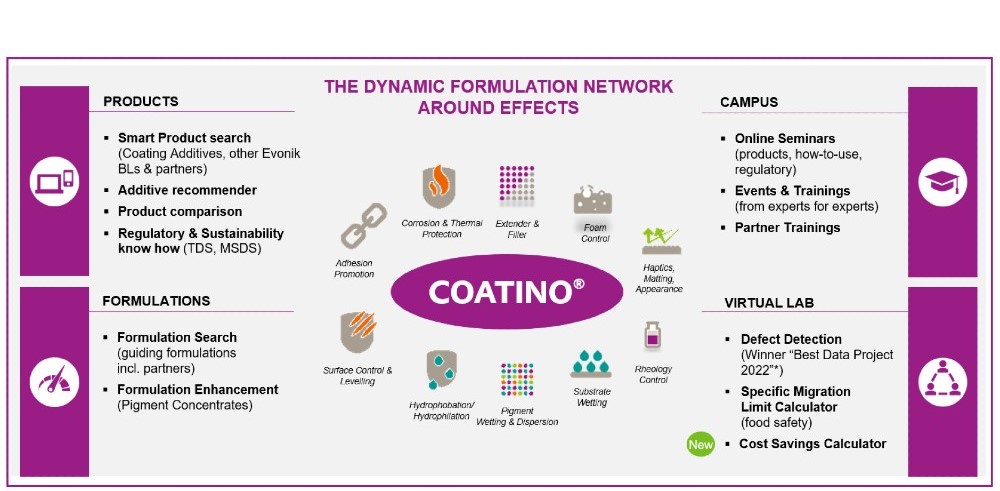 Figure 1: Overview of the COATINO
® tools and functions.
Figure 1: Overview of the COATINO
® tools and functions.
AEROSIL® Easy-to-Disperse technology
Fumed silica for rheology control is popular with formulators – if it weren't for the time-consuming grinding process. Evonik has developed a solution to this problem: With an innovative manufacturing process, we have expanded our AEROSIL® family to include a new Easy-to-Disperse (E2D) product group that is significantly easier to disperse. The new product group, consisting of AEROSIL® E 805, AEROSIL® E 812, AEROSIL® E 972, and AEROSIL® E 9200, is designed in such a way that formulators can omit the time-consuming and costly grinding step, e.g. in a bead mill, when incorporating them into paints or coatings.
Reduction of milling complexity
Increasing customer focus on improving process efficiency has driven raw material innovation to reduce the complexity of the dispersion process. Using a bead mill to create the perfect dispersion is the most technically challenging and time-consuming process step in manufacture of paints and coatings. To overcome this, raw materials suppliers offer dispersions, preparations, and pastes in which the dispersion of insoluble solids (silica, pigments, fillers, etc.) has been optimized.
However, such dispersions may also contain undefined quantities of solvents, water, binders, or additives. While formulators have no control over this, the effects of these components can have a significant impact on the finished coating system.
It would be much easier if manufacturers could use a typical high-speed dispersion to process the solid raw materials for the coating. Unfortunately, the particle sizes that can be achieved by dispersing materials under typical dissolver type dispersion conditions are routinely significantly above the maximum particle size accepted for use in paint and coating products.
Thanks to an innovation in the production process of fumed silica by Evonik Operations GmbH, the standard fumed silica technology routinely used in the coatings industry can now undergo wetting and dispersion processes in a single high-speed dispersion step, instead of in two separate steps (bead mill, dissolver).
Strong advantage for clear coatings and coatings using pigment pastes
The specialty chemicals group's four new Easy-to-Disperse (E2D) products are suitable for rheology control in both pigmented and clear coating formulations. The key applications include wood, plastic, automotive, and general industrial coatings. Both powder coatings and can coatings are typical application fields alike.
AEROSIL
® E 972 is more universally applicable, while the other silicas are designed for specific applications – for example, AEROSIL® E 812 and AEROSIL® E 805 are suitable for automotive OEM clear coats, and AEROSIL® E 9200 is primarily used to improve durability, such as scratch resistance.
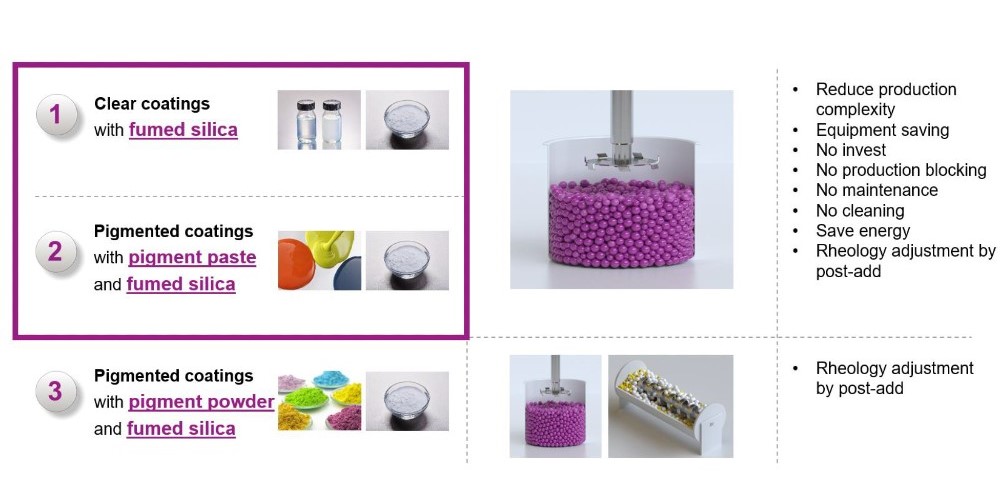 Figure 2: AEROSIL
® E2D offer advantages for every type of coating formulation.
Figure 2: AEROSIL
® E2D offer advantages for every type of coating formulation.
Saving time, energy, and money
The 1:1 replacement of standard fumed silica makes it easy to use the new AEROSIL® E2D grades.
Figure 3 shows a comparison of the two milling processes and highlights the advantage of the low-shear milling step via the dissolver. The benefits can be seen in the significant time savings, as well as the energy and cost savings.
Calculation of time savings for production of 1000 kg clear coating, comparing bead mill to dissolver process
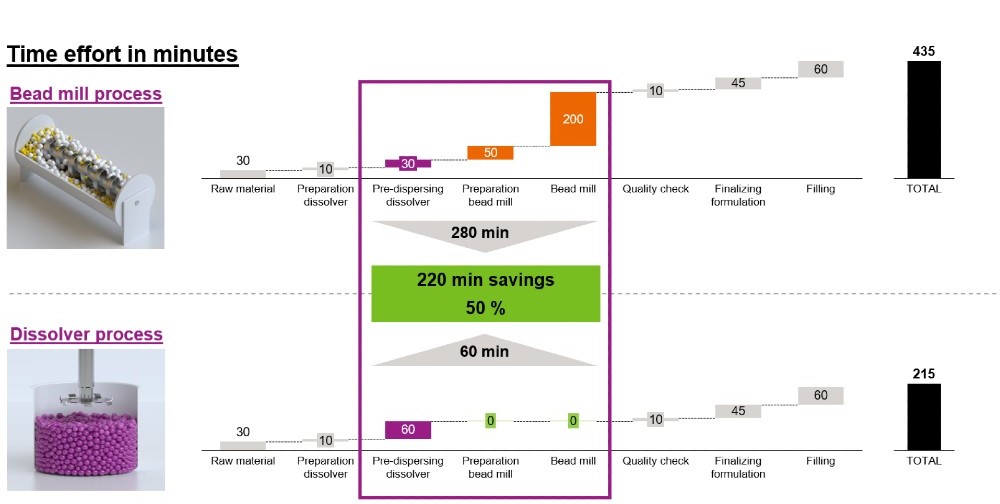 Figure 3: Comparison of high shear milling and dissolver milling regarding time effort.
Figure 3: Comparison of high shear milling and dissolver milling regarding time effort.
Cost Savings Calculator for AEROSIL®
E2D
Evonik Coating Additives business line has developed a Cost Savings Calculator for individual calculation of mentioned savings aspects. With the new COATINO® tool, it is possible to determine the energy consumption of your manufacturing process, compare efficiencies and calculate energy and monetary savings. Using AEROSIL® E2D as an example, the new tool compares the process parameters of high-shear milling with standard fumed silica vs. dissolver milling. Each customer can independently calculate their own savings by using AEROSIL® Easy-to-Disperse with low shear dissolver milling.
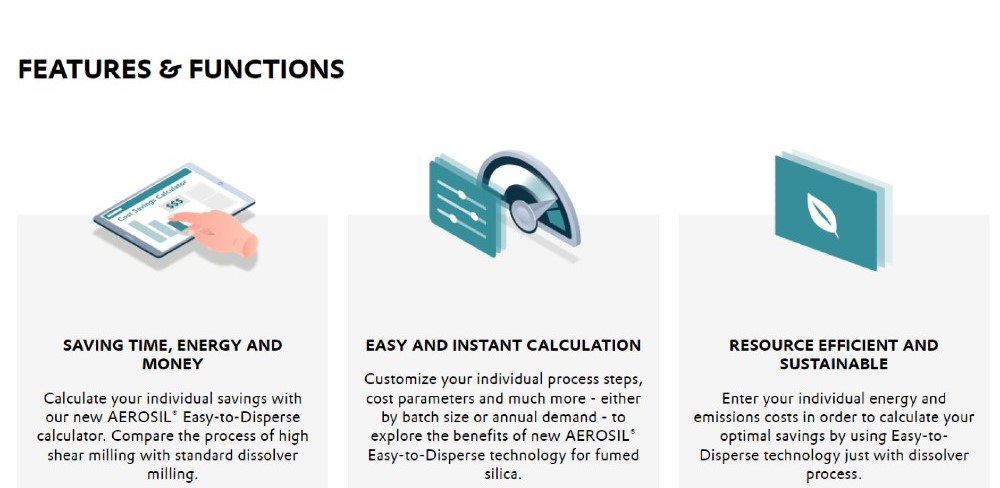 Figure 4: Features and functions of Cost Savings Calculator.
Figure 4: Features and functions of Cost Savings Calculator.
Accessing the calculator is easy, just go to
www.coatino.com
and enter the calculator tool.
The calculator has four different menus: Process parameters, overhead costs, volume and substitution costs and your savings overview. Always visible at the top, your potential energy and monetary savings are updated with each new calculation. You can instantly see your annual savings.
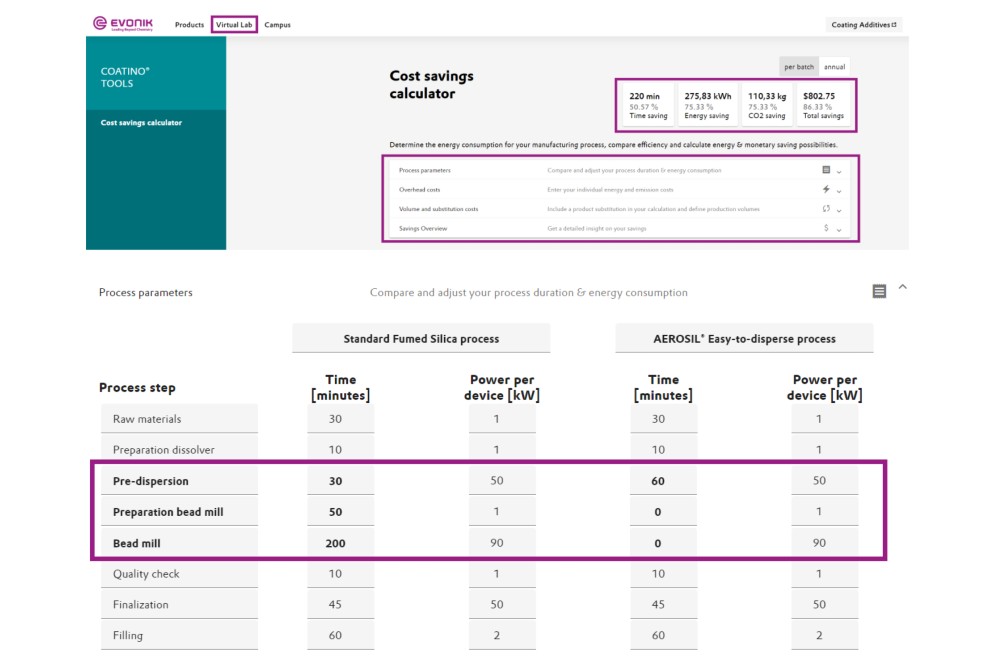 Figure 5: Cost Savings Calculator.
Figure 5: Cost Savings Calculator.
Compare and adjust your own process duration and energy consumption. Each cell can be changed individually. In this specific example, a bead mill process with standard fumed silica is compared to a dissolver process with innovative AEROSIL
® Easy-to-Disperse. Just by using the dissolver process – meaning zero minutes for the bead mill step – time and energy consumption drop immediately.
In chapter overhead costs, enter your individual energy and emission costs. Additional process savings such as cleaning costs and throughput increases can also be considered.
Include product substitution in your calculation and define production volumes. The description text will instantly change based on the values you define.
Do you want to share your results? Simply log in to create a personalized sharing link for colleagues or customers.
Find out more on
www.coatino.com!
On COATINO
® Campus we additionally offer a variety of trainings, lab videos and live event recordings with a focus on new, innovative products.